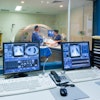Monday, November 28 | 3:00 p.m.-3:10 p.m. | SSE18-01 | Room N229
In this Monday scientific session, researchers will outline a novel approach to differentiating early Alzheimer's disease patients from control subjects. By performing deformable segmentation on the volumes of subcortical structures in the brain, significant differences were found between people with Alzheimer's and healthy volunteers."Volumetric analysis has already been studied extensively in dementia and been shown to help to differentiate Alzheimer-type dementia patients from mild cognitive impairment patients and controls, but the most frequently used methods of segmentation are very computationally intensive," said study presenter Dr. Mark Dalesandro, a second-year fellow at the University of Washington.
Dalesandro and colleagues retrospectively reviewed patients who underwent MRI scans between January 2013 and June 2015 using a protocol that included a standardized volumetric magnetization-prepared rapid gradient-echo (MP-RAGE) T1-weighted sequence to evaluate cognitive impairment.
The overall multivariate analysis of variance (MANOVA) deformable segmentation model showed statistically significant volumetric differences in subcortical gray matter between the control and Alzheimer's groups, with the Alzheimer's patients having smaller mean volumes than the controls. Further posthoc analysis of the MANOVA results illustrated how Alzheimer's patients had significantly smaller volumes in several key regions, such as the amygdala, caudate, hippocampus, putamen, thalamus, and brainstem, and significantly larger lateral ventricles.
"The deformable model method of segmentation is less computationally demanding and, therefore, can be performed faster and on lower-end computers," Dalesandro told AuntMinnie.com. "The goal would be to create a program that can quickly run on the scanner, send to a PACS without requiring a separate postprocessing node, and allow for immediate availability of the segmentation when the MR images are available for dictation. This would hopefully allow radiologists to more easily integrate segmentation data into their practice."


.fFmgij6Hin.png?auto=compress%2Cformat&fit=crop&h=100&q=70&w=100)





.fFmgij6Hin.png?auto=compress%2Cformat&fit=crop&h=167&q=70&w=250)











